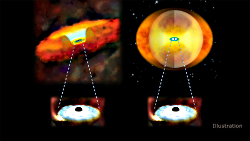 HEAPOW: Growing Your Own Black Hole (2017 May 15)
HEAPOW: Growing Your Own Black Hole (2017 May 15)
Galaxies frequently collide and merge. Mergers play an important role in the driving the evolution of galaxies, and the supermassive black holes that they contain. When galaxies merge, gas and dust in the colliding galaxies mix, and a significant amount of gas and dust can be driven onto the supermassive black holes, increasing the mass of the black hole and driving high-energy activity like the emission of X-radiation as the infalling material accelerates and heats up on its journey to and through the black hole's event horizon. But the amount of material feeding the black hole can be so large that it can obscure our view of this accretion process. A new study using the NuSTAR, XMM-Newton, Chandra and Swift X-ray observatories has allowed astronomers to peer through this obscuration to study the accretion processes which occur very close to the black hole. This is because high-energy X-ray emission can penetrate much larger amounts of material than lower-energy X-rays. So by studying high energy X-rays, and comparing them to emission at lower X-ray energies, astronomers can determine how much material is being funneled into the supermassive black holes, and how it's distributed. The illustration above shows, on the left, the structure of material surrounding a supermassive black hole in an "isolated" galaxy, which is not undergoing a merger event. Absorbing material forms a donut-shaped torus around the supermassive black hole (and its accretion disk, as shown in the inset). In contrast, the righthand illustration shows the distribution of material surrounding a supermassive black hole in a galaxy undergoing a merger event. In this case a thick sphere of material surrounds the supermassive black hole, and a significant portion of this material is funneled into the black hole itself.
NuSTAR: Merging Galaxies Have Enshrouded Black Holes
http://asterisk.apod.com/viewtopic.php?t=37166
| << Previous HEAPOW | High Energy Astrophysics Picture of the Week | Next HEAPOW >> |